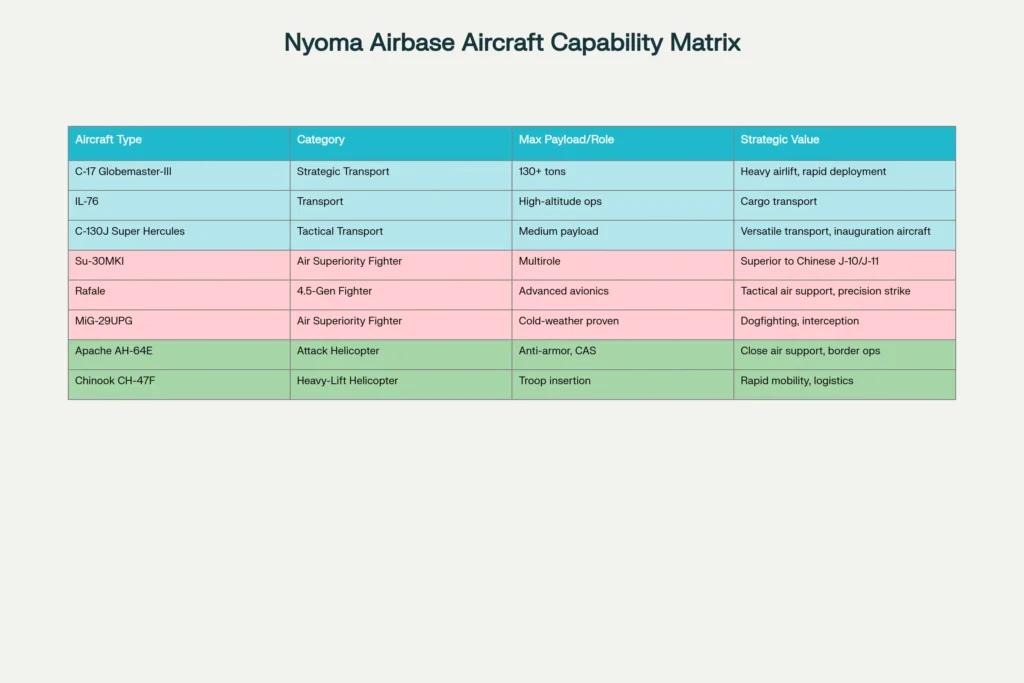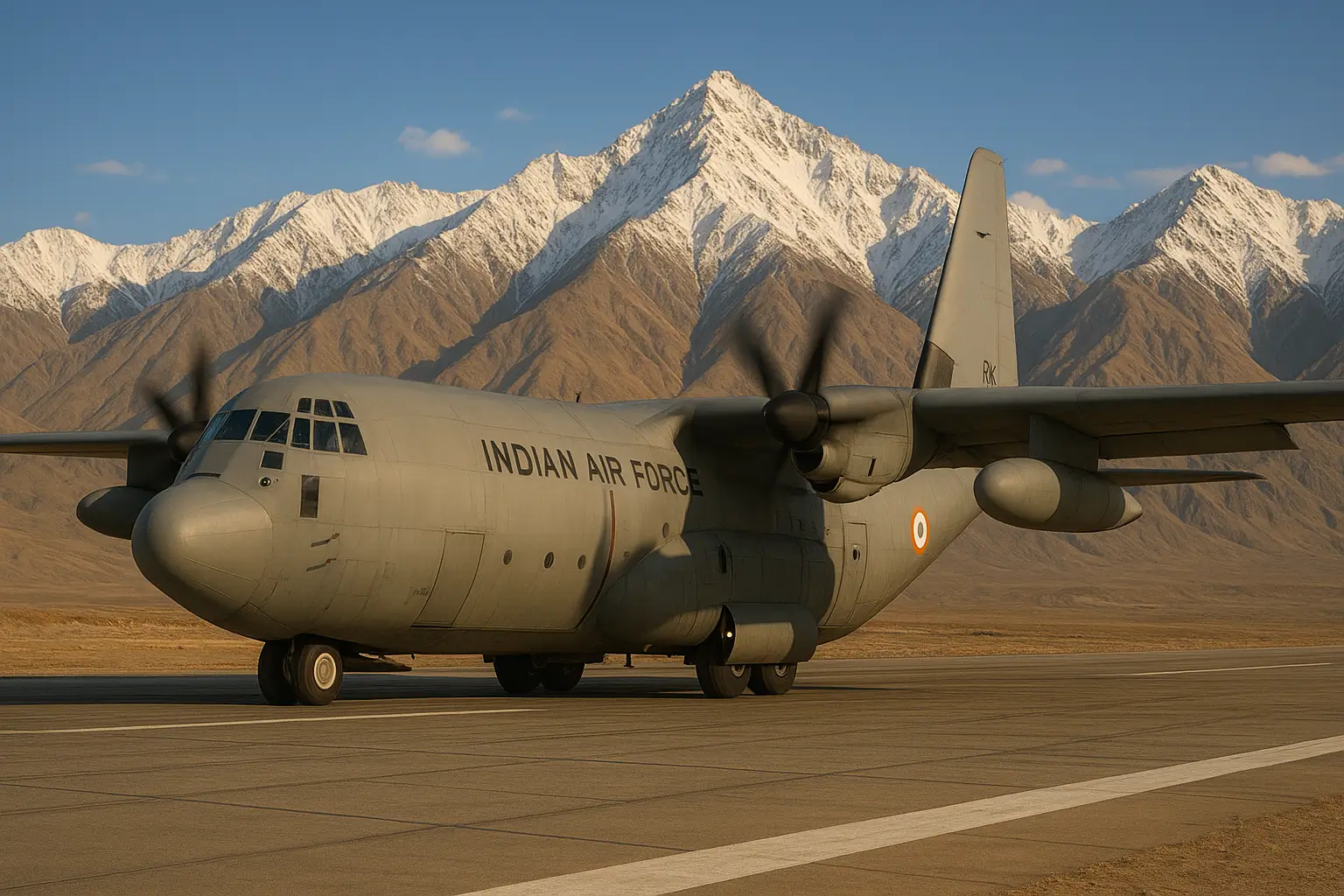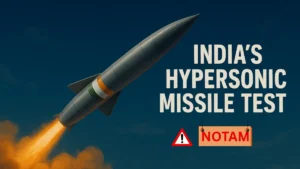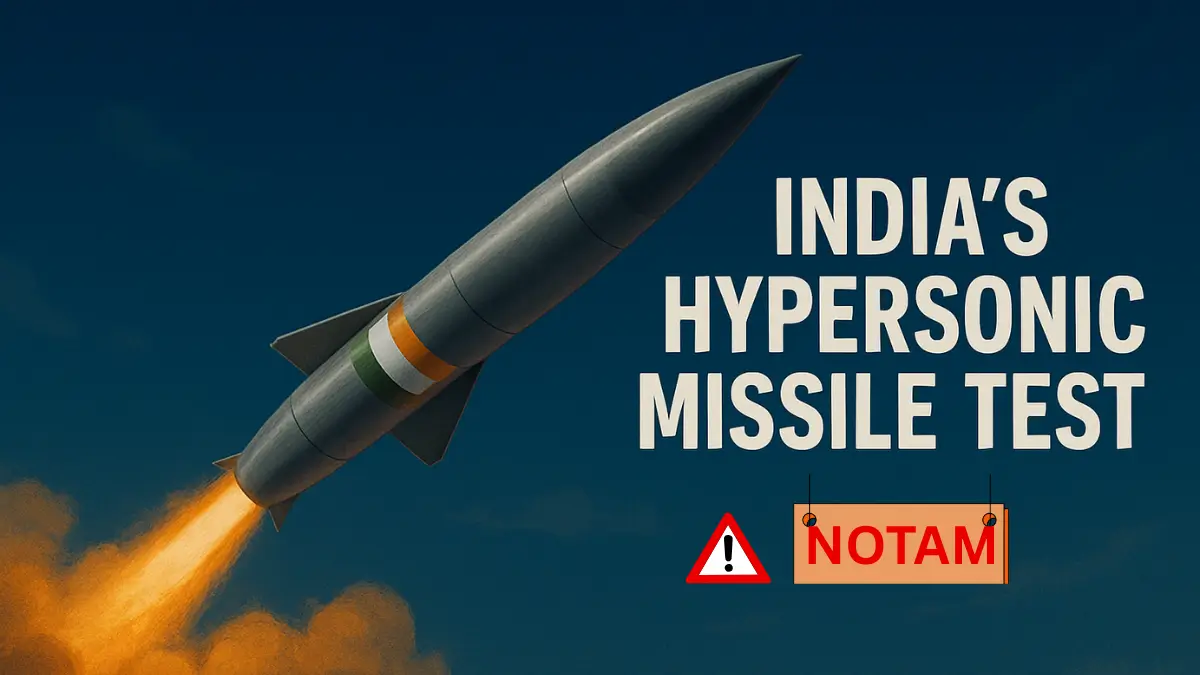On November 12, 2025, India operationalised the world’s highest operational fighter base at 13,700 feet in eastern Ladakh, marking a historic strategic victory. Located just 23–30 km from the Line of Actual Control (LAC), the Mudh-Nyoma airbase represents a ₹218 crore engineering triumph by the Border Roads Organisation (BRO) and fundamentally shifts India’s military posture along the contested China border.
Air Chief Marshal AP Singh inaugurated the facility by landing a C-130J Super Hercules aircraft on the newly constructed 2.7-km runway—a symbolic moment demonstrating India’s capacity to sustain advanced fighter operations at extreme altitudes where most nations struggle to maintain infrastructure.
The Highest Fighter Base: What Makes Nyoma a Game-Changer
Nyoma airbase sits at 13,700 feet above mean sea level, making it the world’s highest operational fighter base capable of sustained combat air patrols and heavy transport operations. Located in Changthang’s remote region near Pangong Tso, the base functions as India’s closest air operations hub to the LAC—closer than Leh (10,682 feet), Kargil, or any other Indian airfield currently handling fighter jets. This proximity dramatically reduces response time for aerial interception missions, enabling fighter jets to reach contested zones within minutes rather than hours.
The airbase’s operational status distinguishes it from India’s higher-altitude facility at Daulat Beg Oldi (14,270 feet), which functions primarily as an Advanced Landing Ground (ALG) with limited fighter jet operations. Nyoma’s comprehensive infrastructure—hardened aircraft shelters, advanced air traffic control systems, precision navigation aids, and high-altitude fuel storage—enables continuous operations across all weather conditions and seasons, eliminating the seasonal accessibility limitations that plagued Ladakh airbases for decades.
Strategic Location: Why 30 km from China Matters
The LAC near Pangong Tso represents one of the most militarily contested regions along the India-China border. In April 2020, military clashes resulted in 20 Indian soldiers’ deaths, triggering a military standoff that lasted months. By placing a fully operational fighter base just 23–30 km from this zone, India demonstrates credible deterrence capacity and rapid-response capability that fundamentally alters military calculations.
Indian Army units resumed patrolling in Demchok and Depsang in 2024, restoring the ground situation to the pre-April 2020 status quo. Nyoma airbase complements this ground presence by providing continuous air cover, surveillance capabilities, and rapid strike potential. Fighter jets stationed at Nyoma can reach Pangong Tso, Demchok, and contested Depsang areas within 8–12 minutes—compared to 45–60 minutes from Leh airbase. This speed advantage transforms Nyoma into a critical force multiplier for India’s border defence posture.
Runway, Aircraft Capability & Extreme Conditions
Nyoma’s 2.7-km runway accommodates a diverse array of military aircraft despite extreme environmental constraints. The facility can handle heavy transport aircraft, including the C-17 Globemaster-III (India’s most capable strategic airlift platform), IL-76, and C-130J Super Hercules. These transport aircraft enable continuous supply missions, ammunition delivery, and troop rotations—critical logistics functions at altitudes where standard aircraft cannot operate.
The fighter aircraft cleared for Nyoma operations include the Su-30MKI (India’s frontline multirole fighter with superior turn-rate capability), Rafale (Dassault’s 4.5-generation fighter offering unmatched agility and sensor fusion), and MiG-29UPG (upgraded Russian air superiority fighter proven in cold-weather environments). Additionally, attack helicopters like the Apache AH-64E and heavy-lift Chinook CH-47F can operate from the facility, enabling integrated air operations across transport, fighter, and rotary-wing platforms from a single hub.

The engineering challenge was extraordinary. Construction occurred during winters when temperatures plummet to −40°C, materials become brittle, and concrete struggles to set properly. The BRO team, including women officers leading critical project management roles, employed innovative high-altitude construction techniques. Foundation depths required permafrost considerations, and equipment winterisation became essential. Despite extreme conditions, the project achieved major runway completion by October 2024—a remarkable acceleration from project sanctioning in 2021.
Project Timeline: From 2023 Foundation to November 2025 Inauguration
Defence Minister Rajnath Singh laid the foundation stone in September 2023, declaring Nyoma a “game-changer” for border defence. The project was sanctioned in 2021 with an original budget of ₹214 crore, later revised to ₹218 crore, reflecting high-altitude construction cost premiums. The acceleration of construction timelines reflected post-2020 border standoff urgency—India prioritised border infrastructure development as a strategic imperative.
By October 2024, the runway construction reached completion despite extreme conditions and logistical challenges of working at 13,700-foot altitude where oxygen levels remain 40% below sea level. October–November 2025 saw the finalisation of allied infrastructure: hardened aircraft shelters protecting fighters from potential missile strikes, advanced air traffic control facilities, and comprehensive fuel storage systems designed for −40°C operations.
November 12, 2025, marked the historic inauguration. IAF Chief Air Chief Marshal AP Singh’s symbolic C-130J landing demonstrated confidence in runway quality and infrastructure reliability. This moment signified India’s transition from seasonal, weather-dependent Ladakh operations to year-round, all-weather fighter base capability at the world’s highest operational altitude.
Global Comparison: World’s Highest Operational Fighter Base
Nyoma’s claim to “the world’s highest operational fighter base” requires precision. While Daulat Beg Oldi (14,270 feet) sits at a higher altitude, it functions as an advanced landing ground with limited sustained fighter operations. China’s Qamdo Bamda airbase (14,219 feet) offers minimal fighter capability despite its higher altitude. Nyoma’s fully operational infrastructure, sustained fighter jet deployments, and advanced systems distinguish it as the world’s preeminent high-altitude fighter base.

This operational superiority carries strategic weight. India now possesses the world’s most capable high-altitude fighter base, capable of sustaining continuous operations at altitudes where most air forces struggle with basic logistics. The facility represents a technological and strategic achievement that elevates India’s regional air power projection capabilities.
Fighter Jets & Aircraft: What Nyoma Can Handle
The C-17 Globemaster-III represents Nyoma’s crown jewel for strategic airlift. This aircraft carries maximum payloads exceeding 130 tons, enabling rapid supply missions and troop deployments. The C-130J Super Hercules provides tactical transport flexibility for shorter-range missions with lower payload requirements. IL-76 aircraft offer Soviet-era proven reliability for high-altitude cargo operations.
Fighter jets deployed from Nyoma include the Su-30MKI, offering superior dogfighting capability against Chinese J-10 and J-11 variants through exceptional manoeuvrability and sensor fusion. The Rafale fighter provides 4.5-generation capabilities, including advanced radar, electronic warfare systems, and precision strike ordnance. MiG-29UPG variants offer additional air superiority coverage and have demonstrated proven cold-weather performance.
Attack helicopters, including Apache AH-64E units, already operated from Nyoma during the 2020 standoff, providing close air support and anti-armour capabilities. Chinook CH-47F heavy-lift helicopters enable tactical mobility for the rapid insertion of troops and equipment. This mixed-platform capability means Nyoma functions as an integrated air operations hub—not merely a fighter base but a comprehensive air power projection facility.
Strategic Significance: India’s Response to 2020 Border Crisis
The 2020 border standoff transformed India’s border infrastructure strategy. Accelerated investment in Nyoma, concurrent road network expansion by BRO, tunnel construction, and bridge projects reflected newfound urgency. Nyoma’s operationalisation represents the culmination of this accelerated infrastructure modernisation effort.
The airbase provides credible deterrence against Chinese aggression through tangible, operational military capability. The mere presence of fighter jets capable of launching missions within minutes sends an unambiguous message: India maintains constant readiness along the LAC. This eliminates any strategic ambiguity regarding India’s willingness and capacity to defend contested territories through air power.
The all-weather operational capability means India can maintain vigilant border surveillance, rapid-response interception capability, and sustained logistics operations regardless of season or weather conditions. Previous constraints limiting Ladakh operations to summer months have evaporated, replaced by year-round, 24/7 operational readiness.
Women Officers Leading the Charge
The Border Roads Organisation team that constructed Nyoma included women officers in leadership roles—a historic milestone for India’s defence infrastructure sector. These engineers managed site operations, quality control, safety coordination, and project scheduling under extreme conditions. Their professional performance overcame altitude-related health challenges, extreme cold, and logistical complexities that would have stalled conventional projects.
This women-led dimension of Nyoma’s construction symbolises India’s commitment to gender diversity in defence sector infrastructure development. It represents untapped potential in engineering and project management ranks and demonstrates that gender-neutral, merit-based recruitment strengthens project outcomes across technical domains.
What’s Next: The Broader Ladakh Infrastructure Boom
Nyoma represents one node in India’s expanding high-altitude air network. The Ministry of Defence is reviving the Chushul Advanced Landing Ground nearby, enabling distributed air operations across Ladakh. Future upgrades to Fukche and Daulat Beg Oldi will create a resilient network of high-altitude air bases capable of redundant operations across multiple platforms.

Parallel infrastructure projects—road network expansion, tunnel construction, bridge development—create an integrated border defence ecosystem. By 2027, Ladakh’s infrastructure transformation will be complete, positioning India for sustained military operations and civilian economic activity at extreme altitudes.
Why NDA Aspirants Must Know Nyoma Airbase
For NDA and CDS exam candidates, Nyoma represents essential current affairs knowledge. Recent defence infrastructure projects consistently appear in General Awareness sections. Potential examination questions include: “What is the altitude of Nyoma airbase?” (13,700 feet); “Which aircraft can operate from Nyoma?” (C-17, Su-30MKI, Rafale); “Why is Nyoma strategically significant?” (LAC proximity, all-weather capability); “Which organization constructed Nyoma?” (BRO); “When was Nyoma inaugurated?” (November 12, 2025).
Defence service interviews value candidates demonstrating current knowledge of military infrastructure modernisation. Understanding Nyoma’s technical specifications, strategic role, and engineering achievements strengthens interview responses and demonstrates serious defence sector engagement.
FAQs |Everything You Need to Know About Nyoma
1. What is Nyoma airbase’s altitude?
Nyoma airbase is located at 13,700 feet above mean sea level, making it the world’s highest operational fighter base.
2. How far is Nyoma from the LAC?
Nyoma is approximately 23–30 km from the Line of Actual Control with China, making it India’s closest operational fighter base to the contested frontier.
3. What aircraft can operate from Nyoma?
Nyoma’s runway accommodates C-17 Globemaster-III, IL-76, C-130J transport aircraft, Su-30MKI, Rafale and MiG-29UPG fighter jets, plus Apache and Chinook helicopters.
4. What was the project cost?
Nyoma airbase cost approximately ₹218 crore (≈$26 million USD) and was constructed by the Border Roads Organisation.
5. When was Nyoma inaugurated?
IAF Chief Air Chief Marshal AP Singh inaugurated Nyoma on November 12, 2025, by landing a C-130J aircraft on the newly completed runway.
6. Why is Nyoma significant for India’s defence?
Nyoma enables rapid fighter deployment near the LAC, all-weather operations, continuous logistics support, and credible military deterrence against Chinese aggression in Ladakh.
India’s Strategic Victory at the Roof of the World
Nyoma airbase operationalised at 13,700 feet represents far more than an engineering achievement—it embodies India’s strategic determination to maintain a credible defence capability at extreme altitudes where most nations cannot sustain military operations. The world’s highest operational fighter base now stands ready, capable of launching Su-30MKI and Rafale fighters at altitudes where competitors struggle with basic logistics.
This ₹218 crore project by BRO transformed imagination into reality. The base’s 2.7-km runway handles C-17 Globemasters, fighter jets, and attack helicopters while operating in −40°C conditions. Located 23–30 km from the LAC, Nyoma fundamentally alters India’s strategic calculus along the China border through rapid-response capability, all-weather operability, and integrated air power projection.
For defence enthusiasts, NDA aspirants, and strategic analysts, Nyoma airbase represents the cutting edge of India’s border defence modernisation. As China modernises its military capabilities, India responds with engineering prowess and strategic infrastructure that ensures credible deterrence capability at the roof of the world.












